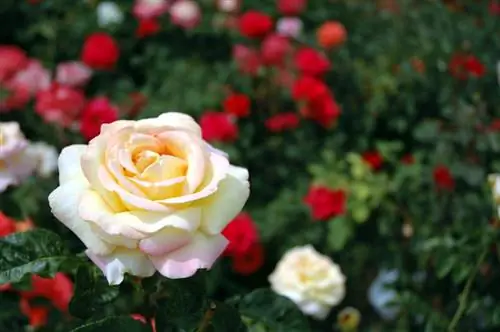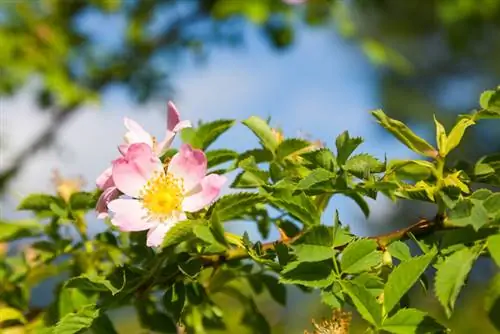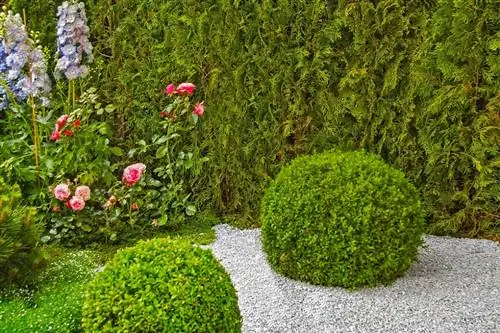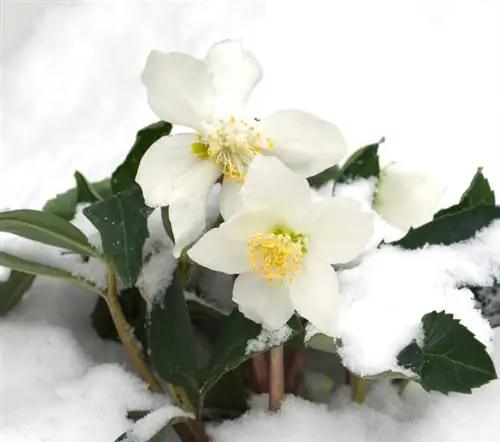- Author admin [email protected].
- Public 2023-12-16 16:46.
- Last modified 2025-01-23 11:20.
It is not without reason that it is called the “Queen of Flowers”: the beauty of the rose has fascinated people for thousands of years. Depending on how you count, there are between 100 and 250 different types of roses in the world, which are botanically classified primarily as wild and cultivated roses. The variety of varieties, on the other hand, is unmanageable.

What are the most important characteristics of a rose?
The rose is a genus in the rose family with 100 to 250 species. It is native to temperate and subtropical zones, has showy, mostly fragrant flowers in various colors and shapes and prefers sunny locations with nutrient-rich, permeable soil. Roses are not poisonous and are known to be medicinal and fragrant plants.
The rose at a glance
- Genus: Roses (Pink)
- Family: Rosaceae
- Species: between 100 to 250 different wild and cultivated forms
- Origin and distribution: depending on the species, temperate and subtropical zones, especially Persia
- Growth height: between a few centimeters (dwarf roses) to several meters (climbing roses and ramblers)
- Typical characteristics: summer green, five-pinnate leaves, spines on the trunk, branches and twigs, flowers often fragrant
- Location: sunny to partially shaded, airy
- Soil: nutrient-rich humus, permeable, preferably containing clay
- Flower: many different colors, shapes and sizes
- Flower colors: mostly red, pink, white, yellow or salmon or apricot; some varieties are two-colored
- Flower sizes: large individual flowers (e.g. noble roses) or smaller flowers in clusters (e.g. floribunda roses)
- Flower shapes: single, semi-double, double or heavily double
- Flowering time: most cultivated varieties bloom in June / July, wild roses usually bloom in May
- Duration of flowering: a distinction is made between once-flowering and repeated-flowering varieties
- Fruits: some roses (especially wild roses) develop rose hips
- Leaves: five-fold pinnate leaves
- Use: for ornamental gardens and containers, as a medicinal and fragrant plant
- Toxicity: no
- Winter hardiness: very different depending on the species and variety
The Story of the Rose
Roses were demonstrably bred by the Sumerians - one of the first human civilizations: The oldest known depiction of a rose is on a 4,000-year-old Sumerian clay tablet. In any case, the land between the Euphrates and Tigris is considered the cradle of the rose, as the first garden roses were probably bred here and eventually spread to the rest of Europe via ancient Greece. From 1780 onwards, merchant marine boats also began to bring home roses from Chinese gardens. These roses came from two wild species: the “Giant Rose,” a gigantic climber with large yellow flowers, and the Rosa chinensis (Chinese Rose), which was found in the Ichang Gorge of the Yangtze River. Since that time, European and Chinese roses have been bred and crossed, resulting in a huge variety of old and new rose types.
Tip
Roses can be used for very different purposes due to their versatility. You can not only plant the shrubs in garden beds or pots, but also use them as ground cover or to green pergolas or similar.






